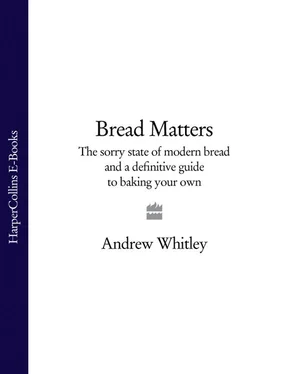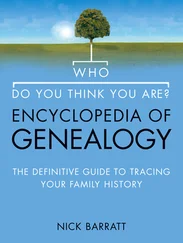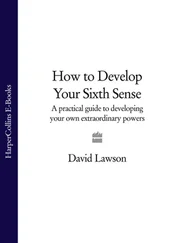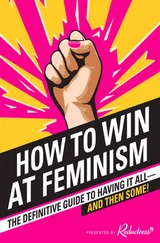In a French study in 2005, stoneground organic flour was shown to have 50 per cent more magnesium and 46 per cent more zinc than roller-milled non-organic flour 10. This effect, it should be explained, was observed not in wholemeal but in flour milled to a finer extraction rate of around 80-85 per cent. Many people consume too little magnesium and the role of zinc in good health is well established. It would not be unreasonable to expect the benefits of organic growing (see page 43) and stone milling to apply similarly to other important micronutrients in flour.
The intriguing question is whether modern roller mills could be adapted to deliver flour with the same nutritional integrity as stoneground. It is hard to believe that the technological ingenuity would be lacking. But commercial will is quite another matter. The track record of the big milling concerns does not suggest a major commitment to the nutritional quality of their flour. Milling technology is currently focused on the functional effects to be had from producing ever finer fractions of flour.
In 1941 nutritional scientists persuaded the government to force a reluctant milling industry to add calcium to its white flour. Three other nutrients (iron, vitamin B 1and nicotinic acid) were added in 1953 – although in lower amounts than would be found in wholemeal flour. All the other deficiencies and differences between stoneground and roller-milled and wholemeal and white flours listed above remain.
Official advice does now stress the importance of whole grain cereals in the diet. However, almost all the ‘whole’ wheat flour produced today is from roller mills. In other words, it is reassembled from the separated fractions of flour but without the crucial wheat germ oil, on the grounds that replacing it would shorten the flour’s shelf life. Perhaps such flour should be labelled ‘reconstituted semi-whole wheat flour’ to alert consumers to the fact that it does not contain all the elements of the original grain.
Ever since our ancestors thousands of years ago noticed that a flour and water paste begins to aerate if left for some hours, people in wheat- and ryegrowing areas have eaten leavened bread. During fermentation, naturally occurring enzymes break carbohydrates down into sugars on which yeasts feed, producing carbon dioxide (the gas that raises the bread) and alcohol. This process was fully understood only after Louis Pasteur’s discovery in 1857 of the micro-organisms involved. It eventually became possible to identify and culture pure strains of yeast that gave fast and predictable results for breadmakers. Of the 160 or so known strains of yeast, the one commonly used for baker’s yeast is Saccharomyces cerevisiae. Other strains are involved in natural leavens and sourdoughs.
Before the development of commercial yeast in the late nineteenth century, bakers had to make their own, either with a ‘wild’ sourdough culture or by making a ‘barm’, which may have been seeded with yeast residue from a brewery. Either way, the process took time because the number of viable yeast cells in a sourdough or barm was relatively small. When commercial yeast became available, it contained much larger populations of cells and worked quickly. But it was expensive, and the thrifty baker could make it go further by using a small quantity in a preliminary ‘sponge’ consisting of a proportion of the flour and water to be used in the bread. This was allowed to ferment for 12 to 24 hours: given warmth, water and food, the yeast cells multiplied. On the following day, fresh flour and water (and occasionally some fat) would be added to make the final dough.
Even when commercial yeast became accessible to all bakers in the twentieth century, the ‘sponge-and-dough’ method remained a favoured way of breadmaking. In a typical overnight recipe from John Kirkland’s famous 1907 manual, The Modern Baker, Confectioner and Caterer, the yeast quantity is less than 0.1 per cent of the final dough weight. According to The Master Bakers’ Book of Breadmaking (National Association of Master Bakers, 1996), the Chorleywood Bread Process needs 2.38 per cent yeast for Vienna bread and rolls. In other words, over 23 times as much initial yeast as in Kirkland’s sponge-and-dough bread. Even compared with the fastest pre-War doughs, the Chorleywood Bread Process uses over three and a half times as much yeast.
If, after several decades in which most bread has been made with increased amounts of yeast, significant numbers of people develop an intolerance or allergy to yeast, it seems reasonable to ask whether there is a link. And there is another thing. Yeast, like the other raw materials of baking, has changed. It, too, needed a makeover if it was to be up to the task of Chorleywood baking. According to a manual for professional bakers, Baking Problems Solved (Stanley Cauvain and Linda Young, Woodhead Publishing Ltd, 2001):
‘When the CBP was introduced in the 1960s the type of baker’s yeast then used was unable to provide carbon dioxide gas in the critical early stages of baking and it became necessary for the yeast strain to be changed. Though the precise nature of the changes is not public knowledge it undoubtedly was related to the enzyme activity within the yeast cell.’ There’s an ominous note in that second sentence: the precise nature of the yeast used to make our national bread is ‘not public knowledge’. This was the 1960s – long (we thought) before the creeping capture of science by private business and certainly a good 20 years before the first emergence of genetic engineering.
For almost all of mankind’s baking history, bread had taken a long time to rise. Bakers’ barms or sourdoughs contained relatively sparse populations of mixed strains of ‘wild’ yeasts. Whatever they were and wherever they came from, the one thing they had in common was that they worked slowly. The whole process from starter dough to finished product could take 24 hours or more. Single varieties of the most active strains of yeast appeared in the late nineteenth century and made faster fermentation possible. Though convenient, this was an expensive commercial option and most bakers eked out their yeast by using the sponge-and-dough method described above.
As the price of yeast came down and productivity pressures grew, fermentation times shortened. With the invention of the Chorleywood Bread Process, the goal of ‘instant’ dough became attainable. With new machinery, ingenious chemistry and a terrific blast of (ever so slightly modified) yeast, bread needed no fermentation at all.
It was good for business, of course, and the manufacturer’s costs could be contained or reduced. Everyone could now afford the whitest, softest bread they had ever known, though, curiously, consumption kept on falling.
Research has recently revealed that making yeasted breads quickly may not leave time for important changes to take place. For example, fermenting dough for six hours as opposed to 30 minutes removes around 80 per cent of a potentially carcinogenic substance called acrylamide that is found in bread crusts 11, and long yeast fermentations conserve the highest levels of B vitamins in dough (48 per cent of vitamin B 1is lost in rapidly made white bread) 12.
Traditional bakers know that the longer you ferment your dough, the better the bread keeps. Time invested in the making is repaid in the eating. Modern bakers and retailers have destroyed this elegant balance. They have stolen time from the production process, a theft they try to disguise in contradictory ways. In the case of standard sliced and wrapped bread, they use additives to keep the crumb soft (or ‘fresh’, as they would say) for a week or more. With the unwrapped bread, on the other hand, time is distorted in a rather different way.
Читать дальше












